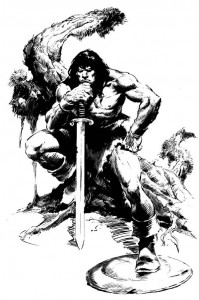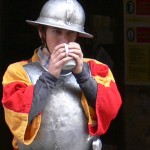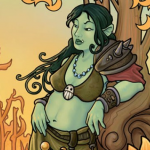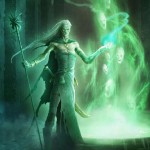Running from goblins, we barricaded ourselves in a dead-end room. Tavis’s fighter spiked the door closed, and then prepared a surprise for the goblins: holding his torch ready, he poured a flask of oil in front of the door.
Unfortunately for us, we had already played these tricks on this band of goblins, and they had learned. The next thing we heard was hammering around the perimeter of the door: the goblins were spiking US in. And then we saw more oil trickle into the room from under the doorframe.
And that’s how we ended up locked and barricaded in a room that was on fire, huddled in the corner and dying of asphyxiation.
Old-school players talk a lot about player skill. As a new-school player, I’ve never really grasped what they meant. It it tactical skill? A set of procedures for dealing with common dungeon hazards, like tapping floors with ten-foot poles? The ability to read the DM and tell when he was planning something devious? What does it mean to be good at D&D?
As Mike Mornard DMed us through a brown-book OD&D dungeon crawl, he told us a little about player skill. Apparently, among the original Greyhawk players, Rob Kuntz was good at D&D. He was good enough to adventure solo, not even bringing henchmen, and survive threats that would threaten whole parties of less skilled players. Once Kuntz started going on solo dungeon delves, it became the thing to do, even among other players who didn’t have Kuntz’s player skill.
Mike told us the story of one of Gary’s lesser players who decided to go adventuring alone. He encountered a room filled with gems. Apparently, he didn’t suspect that Gary was trying anything devious: he ran into the room and started reveling in his treasure. “It’s great!” said Gary (from behind his file cabinet, presumably). “You’re in gems up to your ankles!”
The player showered himself with gems like Daffy Duck. “I’m independently wealthy!” (As a one-time recipient of a cache of random gems, I can relate to the player’s joy.) “It’s great!” said Gary. “You’re in gems up to your knees!” The player shoveled gems into his pack. “It’s great!” said Gary. “You’re in gems up to your waist!” I’m sure you can see where this story is going. When the player tried to leave, he found out that he was sinking in quicksand covered with three inches of gems.
So what does a skilled player do when presented with an unfamiliar dungeon situation?
Earlier in our adventure, before we were trapped in a burning room, we encountered a glowing dagger, floating in the air, blade pointed downwards. I’m new to OD&D. My instinct was that this was similar to all the “trips and tracks” listed in the first edition Dungeon Master’s Guide, like altars that might increase your Strength by 1d4 points or make you save vs. poison or die, with no way to determine between them. If it was either a treasure or a “gotcha” trap, I decided that I would take a risk and grab the dagger, fully aware that I might be arbitrarily zapped for my trouble.
One of the players, wiser than I, probed around the floating dagger with a 10′ pole and met resistance. And then the dagger lurched forward and attacked. As you probably figured out, it was a gelatinous cube.
We defeated the cube: I think the wizard delivered the killing blow, and we got a +1 dagger for our troubles. I realized that I had played the situation wrong. I know about gelatinous cubes, and I should have expected to find one in an old-school dungeon. The floating dagger was a mystery to which I held the clues, and I assumed that it was a logic-defying crapshoot.
Lesson two was this: when Mike Mornard is DMing, assume that you’re speaking in character. We entered the dungeon with a lot of hirelings: we had hired a dozen bandits last session, and this session we hired half a dozen heavy footmen. At three people per rank, our expedition filled about twenty feet of 10-foot-wide corridor.
Our party was so unwieldy that the wizard joked about letting the dangers of the dungeon doing our downsizing for us. The hirelings heard him, and they were not happy. A few bad reaction rolls later, and my bandit followers abandoned us in the dungeon.
We should have foreseen this, because Mike’s NPCs tended to join into our out-of-character strategy conversations. When we lost a heavy footman, and we were discussing whether it was worth it to get him resurrected, the other heavy footmen weighed in strongly on the “pro” column.
This isn’t the way I’m used to playing. Our 4e characters must have instantaneous telepathy, because we routinely spend minutes deliberating about each six-second combat round. And we often reach an out-of-character group consensus before we talk in-character to any NPCs.
Lesson three: sometimes it’s better to be lucky than good. I mentioned that we ended up trapped in a burning room, a round or two away from asphyxiation. After we’d failed our attempts to bash through the door, the dwarf’s player decided to charge through the fire and attack the door with his axe. He rolled a critical hit, which, in Mike’s game, means you get to roll two damage dice. The dwarf rolled thirteen points of damage. He burst through the door and scattered the goblins, and soon we were chasing them.
When the session ended, we put away the snacks and the players headed out towards the subway, discussing what we learned. Don’t taunt the hirelings. Don’t expect to get something for nothing. Keep the offensive: don’t spend a lot of time in deliberation, and don’t wait for the monsters to get organized.
I’m still not sure what player skill is in OD&D, and I still think it has something to do with battle tactics, trapfinding procedures, and gaming the DM. But I’m also starting to think it has something to do with respecting the gameworld as a world. Monsters learn. Henchmen want riches and safety. PCs can’t communicate telepathically. And if you’re a dwarf fighter, sometimes your best course of action is to hit something with an axe.





















